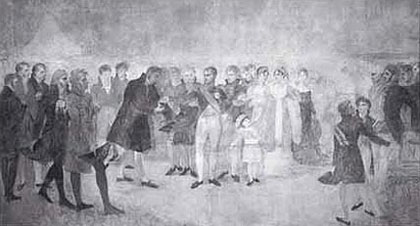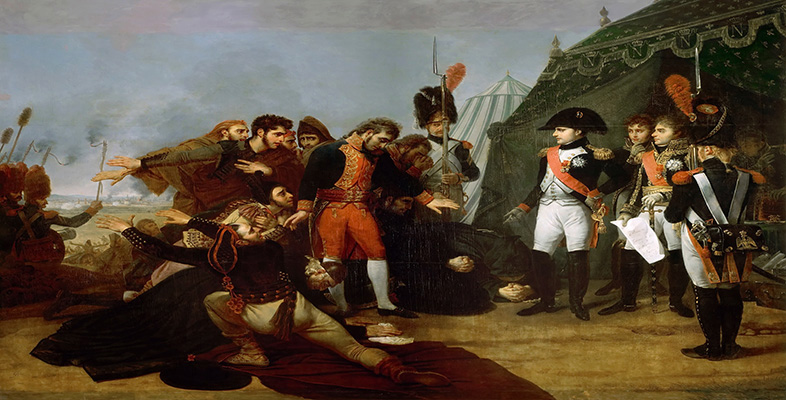3.6 Supporting Napoleon's bulletins
The scene broadly accords with Napoleon's bulletins, which similarly focus on the Russian casualties and, in expressing sorrow at the horrors of the battlefield, imply that the blame lies with other leaders: the sight, he wrote, ‘is made to inspire in princes the love of peace and the abhorrence ofwar’ (quoted in Prendergast, 1997, p.163). The incident with the Lithuanian was apparently Denon's invention. In his letter announcing the competition, Denon justifies the choice of moment by claiming it was made on the grounds that all battles resemble each other. He also says that the commission could simply have been entrusted to the ‘painter of the hospital of Jaffa’, who has ‘already so well depicted a subject of this kind’, but that it was only fair to give all artists a chance to secure it (Anthology I, p.123). This comment not only acknowledges the resemblance in subject to Gros's earlier painting, but also serves to justify the staging of a competition (Denon would have preferred to give the commission directly to Gros). The regime had ceased to allocate commissions by this means, largely because it did not allow it to have sufficient control over the result. There was also the risk that the public might dispute the jury's choice of winner. On this occasion, it reverted to this democratic practice in order to involve as many people as possible in the commemoration of the ‘victory’ but maintained strict control, with the result that the 26 competition entries were all quite similar. The example shown here is by Charles Meynier (1768–1832) (see Plate 22 [Tip: hold Ctrl and click a link to open it in a new tab. (Hide tip)] ), who was placed second in the competition after Gros.
Click to see plate 22 Charles Meynier, Napoleon Visiting the Field of the Battle of Eylau, 1807, oil sketch, 93 x 146 cm, Châteaux de Versailles et de Trianon. Photo: Bridgeman Art Library
Exercise
What are the principal ways in which Gros's painting differs from Meynier's sketch, and what effect do they make?
Note: the wounded Lithuanian is the figure with upraised arm on the far left; the figure in the green coat is Murat.
Discussion
Both compositions show Napoleon on horseback in the centre, but while Meynier depicts him looking straight towards the wounded Lithuanian, in Gros's painting his eyes are turned upwards and his hand is raised much higher as if in a gesture of benediction so that the spiritual aspect is emphasized. Gros also adds a Russian soldier kneeling by Napoleon's horse and leaning forward to kiss his imperial eagle, suggesting (as in Jaffa) that contact with the emperor's body has a miraculous power. Another difference is the much greater prominence that Gros gives to Murat, on a rearing horse and sumptuously dressed; the contrast with this bold and assertive figure highlights Napoleon's saintly compassion and further distances him from responsibility for the horrors on view. In Meynier's composition, the dead and dying in the foreground are (somewhat grotesquely) naked, but they do not dominate the space as much as those depicted by Gros, which lie in a confused heap, snow-sprinkled and blood-spattered, right across the front of the picture; there is even a corpse lying virtually beneath Napoleon's horse. Gros's foreground figures are also more vigorous, especially the wounded soldier on the right who pulls away from the doctor trying to tend him with a horrified expression on his face. In sum, Gros goes to greater extremes than Meynier, both in his exaltation of Napoleon and in his depiction of the horrors of the battlefield.
Although the prominence of the foreground figures disconcerted the critics when Eylau was exhibited in 1808, this can hardly be the result of any personal disaffection with Napoleon. In fact, Gros was so thrilled when the emperor gave him the Legion of Honour at the Salon that he proposed to celebrate the moment in a painting (see Figure 8). For one thing, in his treatment of the foreground, he was only taking advantage of a freedom that he was explicitly granted by the terms of the competition. Denon's letter states: ‘Everything that is movable in the foreground is left absolutely up to the painter’ (Anthology I, p. 124). In any case, all the entries included similar (if not so brutal) details. A police report on the exhibition of the sketches stated uncomprehendingly that ‘the artists have accumulated every kind of mutilation, the various results of a vast butchery, as if they had to paint precisely a scene of horror and carnage, and make war abhorrent’ (quoted in Prendergast, 1997, p. 17). The reason that the regime positively encouraged artists to engage with such subject matter is related not simply to what happened at Eylau but, more generally, to the profound war-weariness of the French people by this date. A major indicator of this was a growing resistance to conscription; significantly, one critic described the cheerful mood of Boilly's The Conscripts of 1807 (seePlate 23) as ‘unnatural’ (quoted in Boime, 1990, p. 48).

Click to see plate 23 Louis-Léopold Boilly, The Conscripts of 1807 Parading Past the Saint-Denis Gate, 1807, oil on canvas, 84.5 x 138 cm, Musée de la Ville de Paris, Musée Carnavalet, Paris. Photo: Bridgeman Art Library
If Gros's painting was to succeed as propaganda, it had on some level to address these concerns rather than glorifying Napoleon as an invincible leader (which would not convince anyone). The regime's concern to appear to be responding to public opinion, which no doubt also contributed to the decision to stage a competition, can again be attributed to Napoleon's problems of political legitimation and his need to justify his authority as deriving from the people. In Eylau, therefore, the suffering caused by war is acknowledged (though displaced on to the enemy's soldiers), but the admission is counterbalanced by the portrayal of Napoleon as a humane leader. In other paintings of the later empire, the exploration of the experience of ordinary soldiers is given free rein. A notable example is The Wounded Cuirassier (see Plate 24) by Theodore Géricault (1791–1824), which depicts a cavalryman retreating from battle and owes a considerable debt to the work of Gros. The latter undoubtedly did play an important role in the move towards a new and typically ‘Romantic’ concern with suffering and with subjective experience. The crucial point, however, is that the initiative for doing so came not from Gros himself but from the Napoleonic regime.
Click to see plate 24 Théodore Géricault, The Wounded Cuirassier, 1814, oil on canvas, 358 x 294 cm, Louvre, Paris. Photo: Bridgeman Art Library
